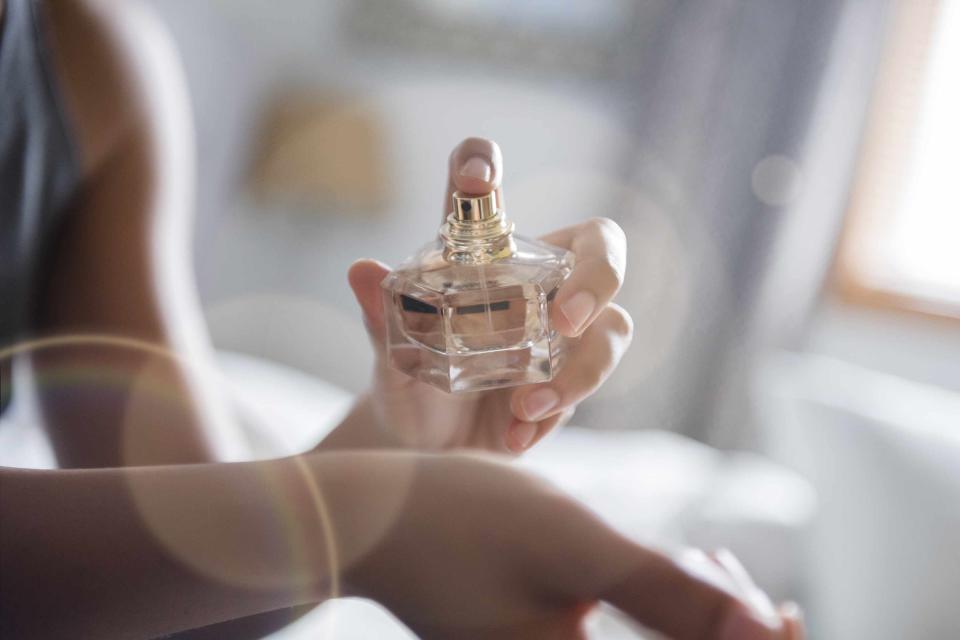10 Most Common Perfume Notes and What They Mean, According to Fragrance Experts
This will make fragrance shopping a lot easier.

Jamie Grill/Getty Images
How someone reacts to a specific fragrance can also be deeply personal—an expression of not only who you are and what you love, but also any past experiences you might associate with a given scent. “If your greatest memory of childhood is grandma baking chocolate chip cookies, your response to that smell will be different from someone whose grandma burned the house down while baking chocolate chip cookies,” says Mark Crames, a longtime fragrance evaluator, developer, and CEO of Demeter Fragrance Library. “That said, there are general rules about the feeling a fragrance will evoke, and the statement a fragrance makes.”
Your feelings toward a certain fragrance can also fluctuate depending on the time of year. “Some people prefer to wear a lighter fragrance in the summer (often florals or citruses) and a richer and warmer fragrance (often spicy or warm notes like amber or musk) for when they’re feeling cozy in the winter,” adds Joyce Barnes, a fragrance expert and Chief Operating Officer at TOCCA.
Curious to know more about your current spritz, or looking to expand your perfume profile? Crames and Barnes helped us break down some of the more common notes and what each—at its base level—might reflect or bring out in you.
Vanilla
As Crames points out, vanilla is generally associated with sweetness. “For many, it tends to evoke feelings of comfort, warmth, and happiness—perfect for the baking enthusiast or calming soul,” he says. “It has a duality to it, for many representing a sense of innocence and others an aphrodisiac thought to increase arousal for the one wearing the fragrance and those who manage to get close.”
“As a gourmet scent, vanilla can also lend a hint of nuttiness and sweetness when paired with another scent, such as a floral,” adds Barnes.
Chocolate
Chocolate (or more specifically, cacao) is another scent that’s often associated with sweetness and pleasure, hence why it’s so often associated with love and Valentine’s Day. “Chocolate tends to appeal to those who are decadent or have a sweet tooth,” says Crames. “It can also come across as too rich or a tad naughty, making it one of the lesser-used sought-after scents.”
Florals
According to Barnes, floral fragrances tend to have a broad appeal due to the wide variety of botanicals that can go into a floral fragrance. “You can have spicy flowers, powder flowers, green or spring flowers,” she explains. “A lush, classic bergamot gardenia fragrance leans more feminine, while a bright sparkling frangipani brings vibrancy and beachside vibes.”
Citrus
Like florals, Crames notes that citrus offers a wide fragrance profile, with a range of options allowing for intensely personal choices. “They run from exotic (like dragon fruit) to happy and energizing (like sweet orange),” he explains. “But they do not have to be simple—there are complex and thoughtful opportunities such as blood limes and mandarin oranges that are stronger and make more sophisticated statements.”
Rose
Long associated with tradition and romance, Crames says rose is one of those fragrances that has had to evolve over time. “The softer, powdery treatments of yesteryear have given way to more modern treatments that tend to be brighter and greener, appealing to younger customers while still retaining their amorous roots.”
Musk
Similar to rose, musky fragrances have gone through a bit of a rebrand. “Traditional musks tend to be pungent, evoking more of a primal and almost animalistic instinct,” recalls Crames. “When we talk about musk today, however, we are mostly talking about synthetic white musks (like Demeter’s Sunshine) which still have a primal quality while tending to be a bit more transparent. This is great for someone who wants a lighter fragrance that still has a bit of depth.”
Tobacco
Once reserved for men’s fragrances, Crames notes that tobacco is increasingly being used as a fragrant and sensual addition to women’s blends. “It’s great for someone who is looking for some complexity in their fragrance, toeing the line between feminine and masculine scents,” he suggests.
Wood
As Barbes points out, woodsy fragrances tend to be warm, smoky, and sensual. “Someone who’s one with nature or wants to make a more intense statement might gravitate to these earthier notes,” she says.
“While traditionally warm and comfortable, modern interpretations of sandalwood, in particular, tend to veer sexier, now frequently combined with musks, rose, or white flowers or green notes to soften the edges,” adds Crames. “This is another fragrance that has been linked to arousal."
Patchouli
“For most of my career, I felt patchouli got a bad rap, mostly due to its association with cheap synthetic patchouli permeating in the 60s and 70s,” says Crames. “It took Tom Ford to bring back what patchouli can be to the broader public. Today’s patchouli, properly and naturally rendered, has tremendous complexity, no longer reserved for hippies, but anyone looking for an earthy fragrance with greater depth and warmth.”
Ozone
“These watery and fresh air notes come in such a broad variety of olfactory impressions that it’s almost difficult to think of it as a single category,” says Crames. “Think vibrant, outdoorsy notes, reflecting that kind of lifestyle or aspiration. It’s hard to smell many of these notes without feeling uplifted,” he adds, also noting Ozone as a great unisex pick.
For more Real Simple news, make sure to sign up for our newsletter!
Read the original article on Real Simple.

